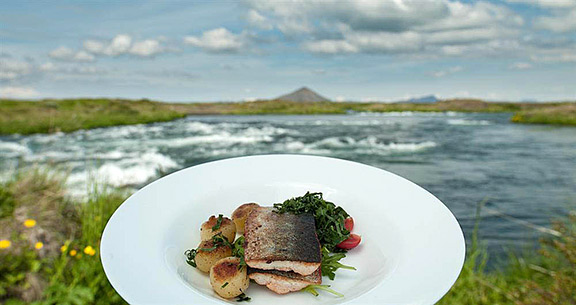
Typical fish dish in Iceland. Photo by Icelandic Tourist Board
"They really didn't pee on the shark. It only smells that way," the chef was telling me as I peered dubiously at a bowl of white cubes amid the pile of curious Icelandic munchies on a wooden tray.
Nothing is more dear to an Icelander than food and in February, after a damp, dark winter where genetic instinct has been screaming, "eat!!!" it all comes to a head in the frenzy of the Thorrablöt festival. Outsiders have to be a bit adventurous for Thorrablöt but to a local, this month of gorging on old Viking food is nothing less than treasured history.
| |
 |
|
Today, Iceland...an Ohio-sized chunk of Volcanic rubble practically atop the Arctic Circle...is all modern buildings, and hordes with their cell phones and polite manners. Visitors forget that these folks are descendants of bold, fearless, somewhat bloodthirsty Vikings. They also forget that snowy volcanic rubble doesn't grow much food and in early days, people weren't very fussy about what they ate. |
|
| |
Local chef with traditional food |
|
|
|
In February, everybody has at least one meal for Thorrablöt (which translates roughly to "homage to Thor"). Icelanders descend on the local grocery and stock up on lamb parts, blood sausage, rotten shark, steamed volcano bread and endless varieties of herring.
But you don't have to wait for February to experiment. Plenty of restaurants in Reykjavik, Iceland's capital city, serve the stuff year round, sometimes complete with a snarling Viking in costume as your guide, should you wish.
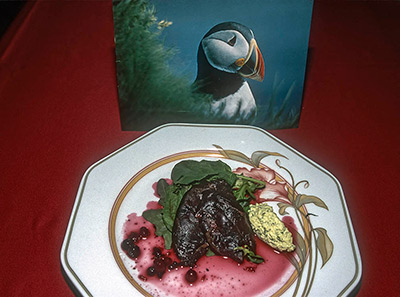 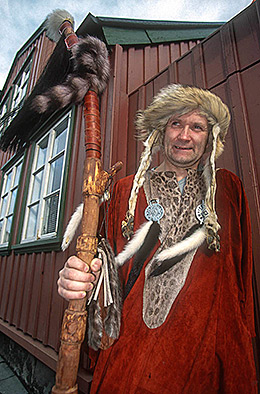
Cooked puffin popular Icelandic dish Local man in viking costume
This is exactly how it went for me on my trip to Iceland. Ever curious about native food...hey, I actually LIKE seal oil...I absolutely had to try old (very, very old) Viking food. Sure enough, a local friend, Jon Bjorgvinsson, trotted out a tray of assorted...stuff.
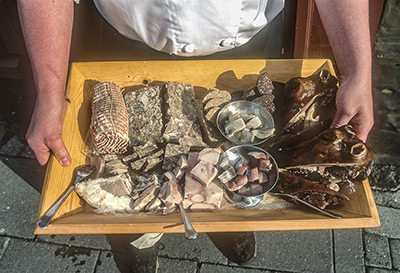
Display of traditional food
He explained the goodies as I nibbled. There was no mistaking the sheep's head, which was singed, then boiled.
"The meat just under the jaw is best," Jon confided as he handed me a forkful.
It was...well...wonderful: silky, tender and intensely flavored.
Next came Slatur (slaughter), a combo of guts, blood, fat and unidentifiable meat bits all neatly stuffed into sausage casings made of stomach lining. Think haggis but not as spicy.
Moving on, the smoked lamb had a distinct taste of campfire, as did all the smoked food I encountered in Iceland. None of that chemical smoke taste you get at home.
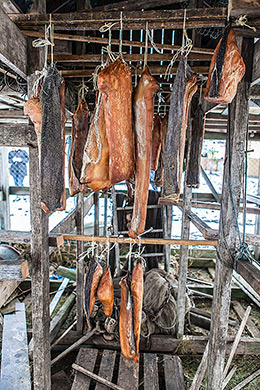 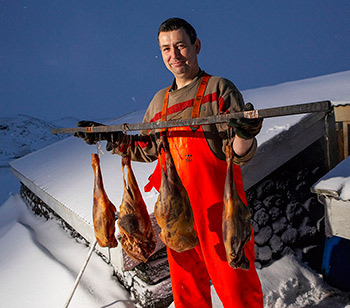
Icelandic fish-drying
Most meat in the old days, however, was packed in sour milk, which turns out to be an extremely effective preservative. This led to a host of somewhat mouth puckering dishes which involved mostly sausages and assorted lamb parts.
But the sour ram's testicles turned out to be an anticlimax. They had been chopped and pressed into little pink chunks with aspic jelly. They looked...and tasted...like lunchmeat.
Jon confessed that people today tend to modernize their Thorrablöt prep routine. But there is one last place in the country where an outsider can get the real thing...no Tupperware for the marinade, no sugar to cut the sour taste of the sausage, no gas lamp to singe the hair off the sheep head.
 
Diners at an Iceland restaurant Traditional foods on table
The Skalholt Church, a one hour drive southeast of Reykjavik, serves traditional food prepared the traditional way (a choice of 17th Century or Middle Ages cuisine). Though it's scheduled sporadically during summer, the good pastors will put on a feast any time of year for groups. (Call first: 486-8870...all numbers in Iceland are local).
And finally, okay, I got to the rotten shark. In the old days, it was buried in sand for weeks, then hung for more weeks. This lent a distinct odor of ammonia, leading to the current legend about the added "secret" ingredient. Today, it's packed in Tupperware for a while, then hung in sanitary little cubicles.
"It's best if you wash it down with this," Jon said, handing me a small glass of Icelandic schnapps appropriately named Black Death.
So I gingerly snagged a bone-white cube and chewed. It felt like gristle. But no, it didn't taste like ammonia or even smell much like ammonia. Mostly, it was salty and fishy. With um, a roquefort aftertaste.
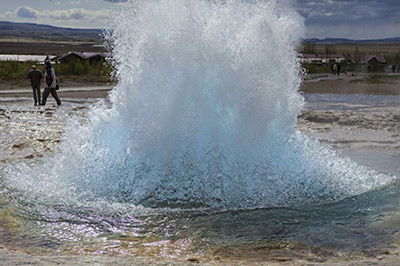  Erupting geyser Northern Lights Erupting geyser Northern Lights
INFO
The height of tourist season is July and August, though people do visit Iceland year round.
Activities in summer focus on the out-of-doors with trips to glaciers, waterfalls and riding stables.
Activities in winter turn to cultural events in Reykjavik, a city where 200,000 people have two dozen theaters.
The weekend bar scene is wicked year round and Christmas month (all of December through the first week of January) is one huge party and buffet.
Should you prefer more standard fare, Iceland also does fish (especially salmon and trout), eggs, lamb, cheese (especially a soft yogurt-like cheese called skyr) and these days, things at upscale restaurants can get quite gourmet)
Contacts:
Icelandic Tourist Board - www.visiticeland.com
Thorrablöt Festival - www.inspiredbyiceland.com/life/thorrablot-a-table-full-of-tradition
|